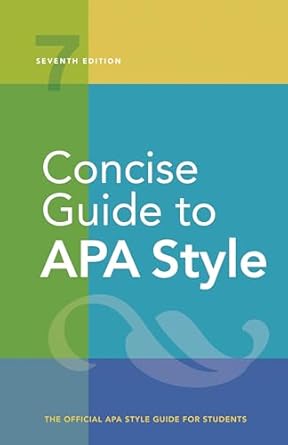[toc]
apa 7th edition citation guide chapters in edited books
Concise Guide to APA Style: 7th Edition (OFFICIAL)
Page 285 Review
Navigating the Labyrinth of Academic Citations: A Deep Dive into APA 7th Edition
Academic writing demands precision, and nowhere is this more evident than in the meticulous art of citation.
The American Psychological Association (APA) style, now in its 7th edition, provides a comprehensive framework for acknowledging sources and ensuring academic integrity.
This commentary will explore various citation scenarios outlined in the provided excerpt, offering insights into the nuances of referencing different types of publications.
Chapter in an Edited Book with a DOI
The excerpt begins with an example of citing a chapter within an edited book, readily identifiable by its Digital Object Identifier (DOI).
According to the guidelines, the reference should include the authors of the chapter, the year of publication, the chapter title, the editors of the book, the book title, the edition number (if applicable), the page range of the chapter, the publisher, and the DOI.
As exemplified by:
“Balsam, K.
F., Martell, C.
R., Jones, K.
P., & Safren, S.
A. (2019).
Affirmative cognitive behavior therapy with sexual and gender minority people.
In G.
Y. lwamasa & P.
A.
Hays (Eds.), Culturally responsive cognitive behavior therapy: Practice and supervision (2nd ed., pp. 287-314).
American Psychological Association. https://doi.org/10.1037/0000119-012″
The excerpt also clarifies how to present the citation in both parenthetical and narrative forms.
For parenthetical citations, the format is: “(Balsam et al., 2019)”.
While for narrative citations, it’s: “Balsam et al. (2019)”.
The importance of the DOI is highlighted as it provides a persistent link to the cited material, enhancing accessibility and verifiability.
Chapter in an Edited Book without a DOI (Academic Research Databases or Print Version)
The excerpt addresses scenarios where a DOI is absent, typically found when referencing chapters from books accessed through academic research databases or in print format.
The citation format largely mirrors the previous example, omitting the DOI and, optionally, including database information.
The excerpt includes:
“Weinstock, R., Leong, G.
B., & Silva, J.
A. (2003).
Defining forensic psychiatry: Roles and responsibilities.
In R.
Rosner (Ed.), Principles and practice of forensic psychiatry (2nd ed., pp. 7-13).
CRC Press.”
The excerpt also show the parenthetical citation: “(Weinstock et al., 2003)”, and narrative citation: “Weinstock et al. (2003)”
The crucial distinction lies in omitting the DOI.
APA 7th edition encourages the inclusion of database information only when the content is exclusive to that specific database or difficult to locate otherwise.
This consideration is crucial for transparency and reproducibility in research.
Chapter in an Edited Ebook or Audiobook without a DOI
The rapid growth of digital publishing necessitates guidelines for citing electronic books and audiobooks.
When citing a chapter from an edited ebook or audiobook lacking a DOI, the reference should include a non-database URL, if available.
The excerpt provides the following example:
“Tafoya, N., & Del Vecchio, A. (2005).
Back to the future: An examination of the Native American Holocaust experience.
In M.
McGoldrick, J.
Giordano, & N.
Garcia-Preto (Eds.), Ethnicity and family therapy (3rd ed., pp. 55-63).
Guilford Press. http://a.co/36xRhBT”
Similar to the previous example, the parenthetical citation should follow the format: “(Tafoya & Del Vecchio, 2005)”, with narrative citation being: “Tafoya and Del Vecchio (2005)”.
The inclusion of the URL allows readers to locate the cited material, even without a DOI.
The excerpt appropriately refers to other examples for audiobook-specific nuances.
Chapter in an Edited Book in Another Language
Navigating citations in different languages presents unique challenges.
The excerpt addresses this with an example of a chapter in an edited book written in Spanish:
“Carcavilla Gonzalez, N. (2015).
Terapia sensorial auditiva: Activacién cerebral por medio de la musica [Auditory sensory therapy: Brain activation through music].
In J.
J.
Garcia Meilan (Ed.), Guia practica de terapias estimulativas en el Alzhéimer (pp. 67-86).
Editorial Sintesis. https://www.sintesis.com/guias-profesionales-203/guia-practica-de-terapias-estimulativas-en-el-alzheimer-libro-1943.html”
The excerpt provided how to use parenthetical citation: “(Carcavilla Gonzalez, 2015)” and the narrative citation: “Carcavilla Gonzalez (2015)”.
The key takeaway is to retain the original title and include an English translation in brackets.
This practice ensures clarity and accessibility for readers who may not be familiar with the source language.
Conclusion
The provided excerpt offers valuable insights into the APA 7th edition’s guidelines for citing various types of chapters in edited books.
From DOI-equipped publications to foreign language materials, each scenario requires careful attention to detail.
By adhering to these guidelines, researchers can ensure the accuracy, transparency, and integrity of their work, contributing to the collective pursuit of knowledge.
Buy full ebook for only $18: https://www.lulu.com/shop/american-psychological-association/concise-guide-to-apa-style-7th-edition-official/ebook/product-rmzpq54.html?page=1&pageSize=4
Apa 7th Edition Citation Guide Chapters In Edited Books
Read more: Student Paper Format: Expert Guide to Organization & Structure


Leave a Reply